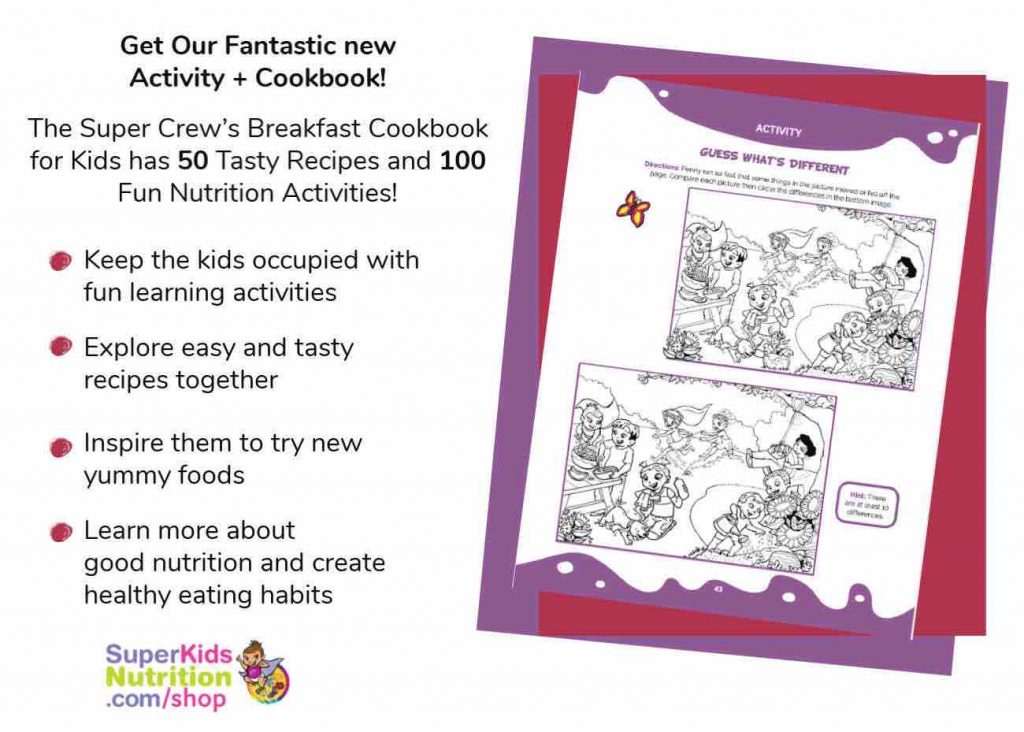
A global pandemic is upon us. Follow these helpful tips to maintain proper nutrition and make the most of your resources during Coronavirus quarantine.
For safety concerns, we are told to self-quarantine until further notice. This is not a drill. I repeat: this is not a drill. At SuperKids Nutrition, we stand by the safety recommendations and encourage people to act responsibly. While it may be difficult, it’s important not to panic. Your home is more prepared than you think for the Coronavirus quarantine.
Take Stock of What You Have
First thing’s first — it’s important to be aware of the food that you have in both your fridge and freezer. Make a list of your items and take note of their expiration dates. Then, keep this handy list in mind as you meal prep. While you may have been excited to dig into your carrots, they will last much longer than your fresh spinach. During the lockdown, get in the habit of minimizing waste and maximizing your food supply.
Don’t forget to subscribe to our free newsletter on our homepage. We have your Coronavirus survival guide coming to your inbox. Learn about everything from meal planning with staple ingredients to transforming your pantry. Let’s make this quarantine experience as stress-free as possible!
Stock Up on the Basics During Coronavirus Quarantine
Fundamental nutrition starts with basic ingredients. In the event of a Coronavirus quarantine, you may want to prioritize the following items in your home.
Canned/Dried Legumes
A true plant-based powerhouse! Legumes are not only a source of complex carbohydrates but protein as well. These fibrous foods are also loaded with vitamins, minerals, and immune-boosting phytonutrients (compounds that give plants their colors). For creative ways to use legumes, don’t forget to check out “5 ways to use lentils.”
- You Have Options: Black. Kidney. Pinto. Chickpeas. Lentils. Split peas. Variety is the spice of life, even under – or especially under – these isolating circumstances. Maintain morale by keeping mealtime delicious and exciting. And don’t be afraid to raid your spice box either!
- Shelf-life. Legumes are a great non-perishable food staple. If this Coronavirus quarantine lasts longer than predicted, it’s essential to be prepared. According to the USDA, canned foods can be stored for up to five years. (1) So, it’s important to dust off those old cans of beans and ensure that none of your items are approaching expiration. By dating all food, you eliminate a future stressful situation! And don’t worry, if canned foods are making up more of your mealtime dishes during Coronavirus, they can be healthy and nutritious.
- Know the Terminology: Understanding the different labels on food packages will give you a better understanding of when they should be consumed. See our article, Food Expiration Dates – Guidelines Charts.
- Buy in Bulk. As if there weren’t enough reasons to buy legumes! If you want to get even more bang for your buck, opt for dried rather than canned legumes. A typical 16 oz bag of dried legumes yields 10-11 servings per bag, while a 16 oz can of legumes only holds 3.5 servings. While the dried legumes take more time to prepare, that won’t exactly be an issue while under quarantine. Soak them overnight, and they will be ready to boil after a good night’s sleep. And if cooking beans typically results in burnt beans (I’m a can girl), just remember eating beans are good for you, even if they’re not homecooked.
- Beans are a Nutritional Powerhouse. Not only do they contribute to both your protein and fiber needs, but legumes also promote longevity. A recent study showed that people who increased their bean consumption by 20 grams a day lived longer! (2) Unfortunately, a single study can’t guarantee that beans will make you live until you’re one hundred. That being said, the results are aligned with the known association between a plant-based diet and a lower risk of chronic disease. Search “beans” on our site and Melissa’s Healthy Living for easy ways to eat them.
- Fiber: ~5-10g/serving (18%-36% of the RDA – Recommended Dietary Allowance)
- Protein: ~8-11g/serving (16%-22% of RDA)
Canned Fish
Everyone’s ole, reliable go-to lunch for generations. But times have evolved from the classic tuna-fish sandwich. There are now a ton of nutrient-rich, canned fish products for you and your family to explore: Salmon. Sardines. Anchovies. Trout. Clams. Oysters. Herring. The list goes on!
- Affordable: Fresh fish can be expensive. In fact, it can range anywhere between $10-$20 per pound. But, the typical canned fish only costs $1-3. Talk about a money-saver! Choose the low-sodium options for an even heart-healthier choice.
- Protein-Packed: It’s an excellent protein source to pump up a gourmet salad or your favorite, kid-friendly pasta dishes. Tutto Bène! Or maybe try something new, like a Salmon Tartine.
- Nutrient-Dense: Fish is loaded with heart-healthy omega-3s. Research has found that having low levels of omega-3 can negatively impact your mood. Low intake of omega-3’s, may be more likely associated with depressive behavior. (3) But, it has been suggested that omega-3 supplementation can possibly help manage some of the symptoms of depression and anxiety. (3,4) Not to mention, being stuck indoors can already cause major mood shifts, due to a lack of vitamin D. (5) Given the isolating nature of quarantine, and poor economic state, the virus has made people more susceptible to changes in mindset. So, maintaining your vitamin levels is more than just about physical health. Now more than ever, look to boost your omega-3s and help turn that frown upside down.
- Omega 3 fatty acids: ~0.3-2g/4oz serving (13%-83% of RDA)
- Protein: ~23-34g/4oz serving (45%-68% of RDA)
- Vitamin D: 250 IU/4oz serving in sardines (63% of RDA)
- B12: 3.3-8.2mcg/4oz serving (54%-134% of RDA)
- Iron: 2.2mg/3oz serving in clams (13% of RDA)
Whole Grains
Whole grains are a vital carbohydrate source that feeds both the body and the brain. They also promote digestive health and serve as a main source of energy. Opt for high-fiber varieties such as whole wheat, quinoa, barley, oats, buckwheat, and more. While some of these grains may be unfamiliar, this is a wonderful opportunity to introduce new foods into your children’s lives. Perhaps switch up spaghetti night with a more fibrous and nutrient-dense quinoa pasta! Even food clubs now sell precooked, vacuum-packed whole-grain mixtures that can easily be added to salad or burrito bowls.
Canned/Frozen Fruits & Vegetables
Packed with vitamins and minerals, canned fruits and veggies are both inexpensive and convenient. These brilliant colors can brighten up even the gloomiest of days in confinement. Select low-sodium or unseasoned options for a heart-healthy and nutritious choice for the whole family. But, before you dive into a hearty can of beans, be sure to inspect the state of its packaging. Is it in good condition? Don’t use any can that is cracked, leaking, bulging, heavily dented, or rusted. If the structure of the can has been compromised, bacteria may enter and make the product unsafe to eat. Also, make sure that your cans are always stored in a dry place that is below 85 degrees F. Avoid storing your pantry goods in cabinets above the stove, or areas that may contribute to food spoilage like a hot garage. (1) The last thing you need under quarantine is a food safety issue. See our guides Food Expiration Dates -Guidelines and Charts or When to Toss It? Food Expiration Guidelines!
Tip: If low-sodium options are unavailable, it’s okay! You can rinse your canned vegetables to remove the excess salt. In fact, rinsing canned vegetables can remove about 40% of its sodium contents. Say goodbye to unnecessary salt. Also, you can buy canned fruit in its own juices. No need to rinse. Freeze the leftover natural juice for popsicles or a tasty slushy. Just because resources are limited does not mean that nutrition needs to be compromised.
Health Staple: With every color comes different vitamins and phytonutrients, all with their own unique role in your health! The key is to diversify your fruits and vegetables. Don’t discriminate! Use your time in Coronavirus quarantine to explore new flavor profiles. Keep the immune system strong by loading up on fruits (RDA: 2 servings/day) and vegetables (RDA: 3 servings/day).

Long-lasting fresh produce
Everyone wants to avoid a crowded grocery store right now. So, you’re going to want to be strategic with which fresh fruits and vegetables you should buy. The trick is to buy long-lasting produce and to avoid a fridge full of wilted greens. Luckily, this type of produce comes in all colors. Don’t forget to make your grocery basket as vibrant as possible so that you maximize your phytonutrient intake.
If strategically selected and maintained under adequate storing conditions, it’s possible to maintain fresh produce for a longer period of time. (6)
Roots/starchy vegetables
- Potatoes: 4 weeks; cool, dark place
- Beets: 2-3 weeks; refrigerated
- Winter Squash: 3-4 weeks; cool, dark place
- Turnip, topped: 2-3 weeks; refrigerated
Non-starchy vegetables
- Cabbage: 2 weeks; refrigerated
- Onion, dry: 4 weeks; cool, dark place
- Carrots: 2 weeks; refrigerated
- Brussel sprouts: 10 days; refrigerated
Fruit
- Citrus fruit: 2-6 weeks; refrigerated
- Apples: a few weeks; refrigerated (6)
Pro Nutrition Storage Tips: While some produce may be more long-lasting than others, it’s still suggested to date all of your food items. Eat in the order of the nearest expiration dates, so as to minimize food waste and maximize your grocery dollars. If you have produce-saving storage bags, now is also the time to use them. Also, don’t store potatoes next to onions, the gases that they each emit will cause the degradation of both vegetables.
Nuts/Seeds and Butters
It’s easy to rely on your favorite junk food while stuck at home. But, if you are looking for a nutrient-dense snack, consider swapping the handful of chips for nuts. Almonds. Peanuts. Cashews. Pistachios. Walnuts. Sunflower seeds. The possibilities are endless. Feel free to enjoy them whole or as a spread. Add nuts and seeds for a boost of healthy fats and savory goodness to Greek yogurt, oatmeal, or your favorite whole-grain toast. If someone in the family has a nut allergy, stick to using sunflower, flax, or chia seeds. Also, a hearty cracker topped with almond butter, banana slices, and a few chocolate chips can really stave off a sweet craving when there are no sweets at home. Check out our Nut and Bolts of Nut and Seed Butters.
- The nutritional profile of nuts and seeds:
- Monounsaturated fat: 7g-11g/ ¼ cup serving (30%-50% of RDA)
- Vitamin E: 8-18mg/ ¼ cup serving in almonds and sunflower seeds (40%-90% of RDA)
- Omega 3 fatty acids: 2-4g/2 tbsp serving in walnuts, flaxseeds and chia seeds (~91%-200% of RDA)
- Fiber: 3g-8g/serving (12%-32% of RDA)
- Protein: 5g-9g/serving (10%-18% of RDA)
In a way, if you’re fortunate enough to be able to stay at home, make the best of it. If you decide to get the house organized -see our tips on how to declutter your kitchen and what you forgot to spring clean. In the end, this situation can be both overwhelming and stressful. But with the appropriate preparation, you can ensure the safety and well-being of your family. Utilize these staple resources and try to find comfort in this new normal. As isolating as this Coronavirus quarantine may feel, you are not alone. Gain some insights into maintaining your well-being during COVID19.
References
- USDA Shelf Stable Food Safety. Retried from: https://www.fsis.usda.gov/wps/wcm/connect/77ffde83-dc51-4fdf-93be-048110fe47d6/Shelf_Stable_Food_Safety.pdf?MOD=AJPERES
- Blackberry-Darmadi et al. Legumes: the most important dietary predictor of survival in older people of different ethnicities. Retried from: https://www.ncbi.nlm.nih.gov/pubmed/15228991
- University of Pittsburgh Medical Center. Omega-3 fatty acids influence mood, impulsivity and personality, study indicates. Retrieved from https://www.sciencedaily.com/releases/2006/03/060303205050.htm
- Kuan-Pin, S et al. Omega-3 Polyunsaturated Fatty Acids in Prevention of Mood and Anxiety Disorders. Retrieved from: https://www.ncbi.nlm.nih.gov/pmc/articles/PMC4540034/pdf/cpn-13-129.pdf
- Alan E. Stewart, Kathryn A. Roecklein, Susan Tanner, Michael G. Kimlin. Possible contributions of skin pigmentation and vitamin D in a polyfactorial model of seasonal affective disorder. Medical Hypotheses, 2014; 83 (5): 517 DOI: 10.1016/j.mehy.2014.09.010
- https://food.unl.edu/food-storage-chart-cupboardpantry-refrigerator-and-freezer
- https://lancaster.unl.edu/hort/articles/2002/potatocare.shtml












